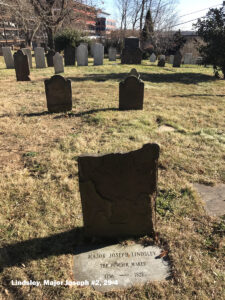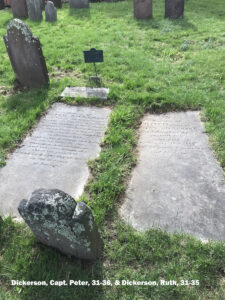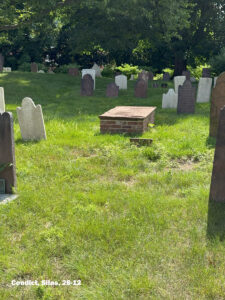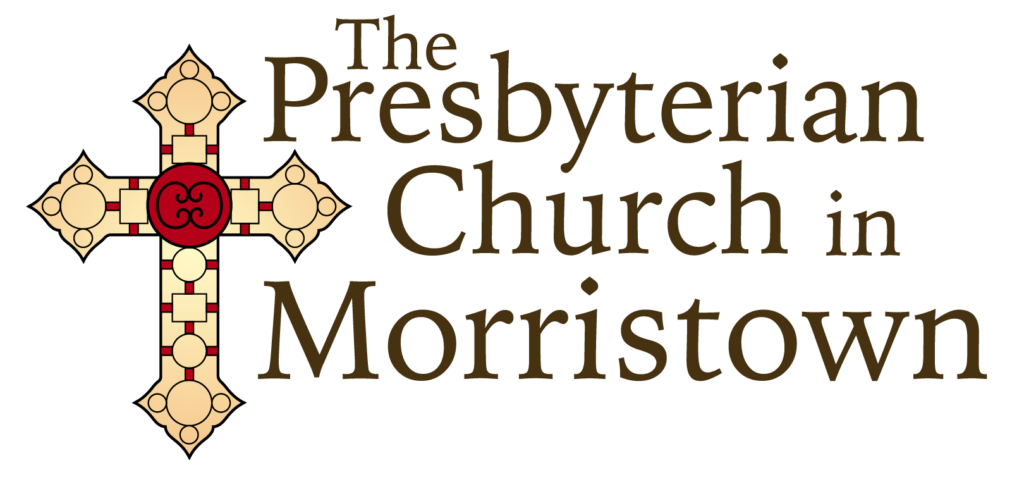Location #3
Under the large evergreen you see as you face toward Headquarters Plaza
Standing under the boughs of the evergreen, notice the grave of Major Joseph Lindsley just to the left of the two “Table Top” markers at the base of the tree. Major Lindsley was an Elder of the church and head carpenter in the construction of our Second Meeting House between 1791 and 1795. It would serve as our meeting house for the next hundred years. Major Lindsley, whose home was near the present site of the Westin Hotel, also managed the Ford Powder Mill following Jacob’s Ford Jr.’s death in 1777.

While still under the boughs of the evergreen and facing toward Headquarters Plaza, look to the left and slightly to the rear. You should be able to see grave of Captain Peter Dickerson. It’s a large grayish white tablet placed flat on the ground about two rows over. Peter was a carpenter and keeper of the tavern at the corner of Spring and Water Streets, which was the site of the first meeting to raise a militia in Morris County in early May of 1775. Peter personally supplied all of the equipment of the Company he commanded in the first year of the Revolution. He is said to have been so popular with those who served under his command, that when other units were being depleted as enlistments ran out at year end in 1776, his troops re-enlisted en masse. During the war, his tavern was leased to Robert Norris, so in some historical accounts it is referred to as Norris’s (or Norres) Tavern. The tavern, which served as the site of the trial of Benedict Arnold for malfeasance in office while Governor of Philadelphia, was largely destroyed by fire in the early 1900s.

As you emerge from under the boughs of the evergreen walking toward Headquaters Plaza, look to the right for the “Table Top” marker (on a brick base) of Silas Condict, Esq. Silas served as Chairman of New Jersey’s Committee of Safety formed to keep an eye on British sympathizers prior to and during the war. Silas served for many years as President of the Board of Trustees of the Church, first having been elected to the Board in 1772. In 1774, the Trustees directed him to take a trip to Perth Amboy, Capital of East Jersey, to record the Church’s Charter. A copy of the Charter hangs in the Tower Entrance of today’s Sanctuary. Between 1781 and 1784, Silas was a member of the Continental Congress. He also served on the committee to draft the first Constitution of the State of New Jersey and as Speaker of the House in the New Jersey Legislature. In 1799, he had a home built by Joseph Cutler which now serves as The Red Oaks School on Cutler Street. Silas Condict’s likeness is one of several historical medallions on the former department store building on the Morristown Green.

At the same spot, i.e., as you come out from under the boughs of the evergreen, to the left there are two large grayish white markers and a large sandstone marker flanked by shorter markers. The large sandstone marker is that of Colonel William DeHart. If you walk around to the front of the markers, you’ll see that Colonel DeHart’s marker has deteriorated badly. This type of deterioration, called “exfoliation,” is caused by expansion and contraction of moisture trapped between the stone’s layers. Colonel DeHart, a lawyer by profession, was authorized to purchase 500 pounds of powder and a ton of lead to be kept in a magazine for the use of the militia being raised in Morris County in the Spring of 1775. The munitions were stored somewhere within his residence which once stood at the corner of DeHart and South Streets.

Now proceed to Location #4.

